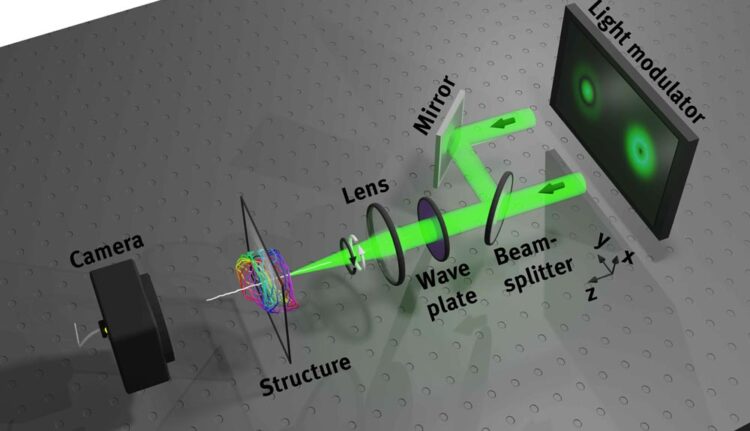Looking into four-dimensional space with light

Optical setup based on a spatial light modulator, which tailores the two incomming beams (not drawn). Their superposition generates the Hopfion structure. Waveplate and beam splitter together generate orthogonal circular polarization for both beams.
© WWU - Ramon Droop
Research team develops for the first time a light field that reflects the structure of four-dimensional space.
Researchers have developed a method for structuring light in such a way that a projection from four-dimensional space is created. The results have now been published in the journal Nature Communications.
Light is used for various purposes in nowadays applications. For example, data can be transmitted with light and nanoscopic structures can be created by light. To enable such applications, light must be structured. To do this, its properties – intensity (brightness), phase (position in oscillation-cycle) and polarization (direction of the oscillation) – are “tailored”. Typically, this results in three-dimensionally structured light fields, for example by using a hologram. Going beyond this, now an international team of researchers led by Prof. Dr. Cornelia Denz of the University of Münster and Prof. Dr. Mark Dennis of the University of Birmingham (United Kingdom) has developed a method for structuring light in such a way that a projection from four-dimensional space is created. The results have now been published in the journal Nature Communications.
The team first predicted the complex light structure theoretically (mathematically) and then realized and measured it experimentally. The structure is called Hopfion, named after the German-Swiss mathematician Heinz Hopf. In simplified terms, it looks like countless rings lying inside each other and its projection into 3d space can be compared to the projection of the three-dimensional earth onto a two-dimensional map. In contrast to this, however, with the Hopfion a part of the four-dimensional space is transferred into the three-dimensional space. This means: From the measurements in the three-dimensional space, conclusions can be drawn about the properties of the fourth dimension.
The search for four-dimensional light fields is keeping the optics community busy because, for example, light structured in this way would provide a way to transmit data faster. “The fourth dimension is a mathematical construction. We cannot spatially imagine four dimensions with our senses,” says physicist Ramon Droop of WWU Münster, one of the study’s first authors.
The scientists developed a method that directs light from two laser beams into a structure about 0.2 x 0.2 x 50 cubic millimetres in size that is interwoven to form a hopfion. They accomplished this by using so-called liquid crystal-based spatial light modulators, which can be used to electrically control the optical properties of the light.
The team also developed a new imaging method that can spatially resolve the properties of light associated with the four dimensions. To do this, the group uses a method similar to tomography of measuring two-dimensional slices, which are then assembled to form three-dimensional space. It is then possible to calculate exactly which part of the four-dimensional space is mapped.
“Based on these research results, new types of laser beams could be developed in the future to make data communications more secure. The arrangement of nanostructures could be made more versatile and simpler, and material processing more precise,” Cornelia Denz gives an outlook.
Wissenschaftliche Ansprechpartner:
Ramon Droop
University of Münster
Institute of Applied Physics
Mail: R.Droop@uni-muenster.de
Originalpublikation:
Danica Sugic, Ramon Droop, Eileen Otte, Daniel Ehrmanntraut, Franco Nori, Janne Ruostekoski, Cornelia Denz & Mark R. Dennis (2021): Particle-like topologies in light. Nature Communications 12, 6785; https://doi.org/10.1038/s41467-021-26171-5
https://www.uni-muenster.de/news/view.php?cmdid=12191&lang=en
Media Contact
All latest news from the category: Physics and Astronomy
This area deals with the fundamental laws and building blocks of nature and how they interact, the properties and the behavior of matter, and research into space and time and their structures.
innovations-report provides in-depth reports and articles on subjects such as astrophysics, laser technologies, nuclear, quantum, particle and solid-state physics, nanotechnologies, planetary research and findings (Mars, Venus) and developments related to the Hubble Telescope.
Newest articles

Innovative 3D printed scaffolds offer new hope for bone healing
Researchers at the Institute for Bioengineering of Catalonia have developed novel 3D printed PLA-CaP scaffolds that promote blood vessel formation, ensuring better healing and regeneration of bone tissue. Bone is…

The surprising role of gut infection in Alzheimer’s disease
ASU- and Banner Alzheimer’s Institute-led study implicates link between a common virus and the disease, which travels from the gut to the brain and may be a target for antiviral…

Molecular gardening: New enzymes discovered for protein modification pruning
How deubiquitinases USP53 and USP54 cleave long polyubiquitin chains and how the former is linked to liver disease in children. Deubiquitinases (DUBs) are enzymes used by cells to trim protein…


